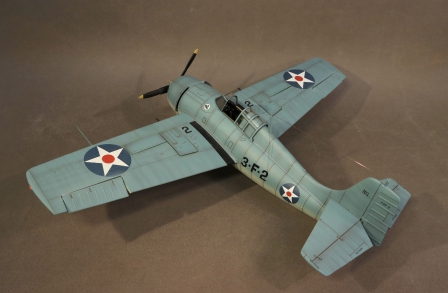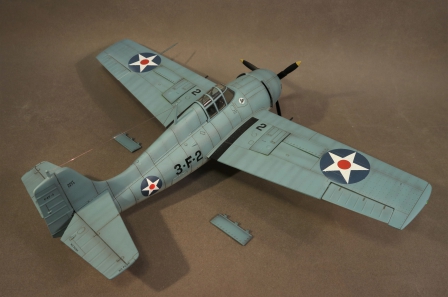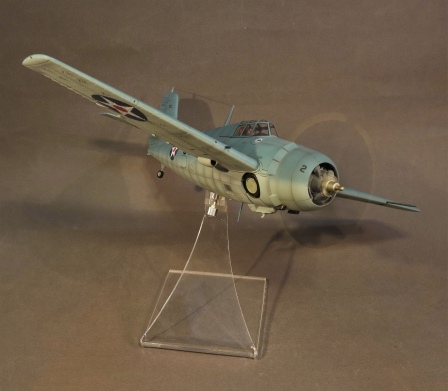
THE SECOND WORLD WAR
AIRCRAFT CARRIERS

SARA-01
Grumman F4F-3 Wildcat,
BuNo3973, Fighting Squadron Three(VF-3)
Uss Saratoga(CV-3),
October 1941
(13pcs)
US$278
The Grumman F4F Wildcat is an American carrier-based fighter aircraft
that began service with both the United States Navy
and the British Royal Navy in 1940,
where it was initially known by the latter as the Martlet.
The F4F was Grumman's first monoplane fighter design
and was to prove to be one of the great naval
fighter aircraft of World War 2.
In 1939 Grumman were successful in obtaining a Navy order for 54 F4F-3's.
The RAF also received 81 F4F-3's which were named the Martlet I.
The initial deliveries to the US navy were in December 1940,
with the first of the planes going to the USS Ranger, and USS Wasp.
These were the only carriers which had the F4F-3's when war broke out.
First used in combat by the British in the North Atlantic,
the Wildcat was the only effective fighter available to
the United States Navy and Marine Corps in the Pacific Theater
during the early part of World War II in 1941 and 1942;
the disappointing Brewster Buffalo was withdrawn
in favor of the Wildcat and replaced as units became available.
With a top speed of 318 mph (512 km/h),
the Wildcat was outperformed by the faster 331 mph (533 km/h),
more maneuverable, and longer-ranged Mitsubishi A6M Zero.
However, the F4F's ruggedness,
coupled with tactics such as the Thach Weave,
resulted in a claimed air combat kill-to-loss ratio of 5.9:1 in 1942
and 6.9:1 for the entire war.
Lessons learned from the Wildcat were later applied to the faster F6F Hellcat.
While the Wildcat had better range and maneuverability at low speed,
the Hellcat could rely on superior power
and high speed performance to outperform the Zero.
The Wildcat continued to be built throughout the remainder
of the war to serve on escort carriers,
where larger and heavier fighters could not be used.
By late 1941 nearly all of the colourful squadron markings
were either gone entirely or existed as quite small example
s close by the cockpit area.
VF-3's famous "Felix The Cat" emblem is thus
reduced to a 6" diameter circle forward of the cockpit on BuNo 3973.
The first WILDCAT F4F-3's to be delivered to the USS SARATOGA
in late 1941 were painted in overall "non-specular Light gray".
The transition to the Blue Gray/light gray camouflage scheme
often came as and when each aircraft reached its major service and over haul point.
Thus each Carrier Air Group at this time may have had a mix of overall
Light Gray and Blue Gray/Light Gray squadrons aboard.
The Grumman F4F-3 Wildcat BuNo 3982,
is based on an U.S. Naval Historical Center photograph,
depicting the aircraft on the elevator of USS Saratoga in early October 1941.
This aircraft was piloted by ensign Gayle Hermann.
The photograph shows that at this time squadrons
were operating with aircraft of mixed paint schemes.
BuNo 3982 is seen in overall Light gray
while other Wildcats on the deck are
painted in the Blue Gray/ Light Gray scheme.
*
*
Please note the undercarriage can be switched and the model placed on any of the jjDesigns Stands*
*
We now accept PAYPAL,
to purchase your figures please send your order by e-mail to
inquiry@johnjenkinsdesigns.com
after checking that everything is available,
you will be billed via PAYPAL.
your order will be shipped on confirmation of payment.
worldwide airmail 15%
(minimum postage us$15)
JOHN JENKINS DESIGNS
UNIT 6E, TOWER 2,
KING LEY INDUSTRIAL BUILDING,
33-35 YIP KAN STREET,
WONG CHUK HANG,
HONG KONG
Tel: 852 9041 9065







